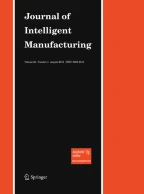Abstract
One of the big challenges in machining is replacing the cutting tool at the right time. Carrying on the process with a dull tool may degrade the product quality. However, it may be unnecessary to change the cutting tool if it is still capable of continuing the cutting operation. Both of these cases could increase the production cost. Therefore, an effective tool condition monitoring system may reduce production cost and increase productivity. This paper presents a neural network based sensor fusion model for a tool wear monitoring system in turning operations. A wavelet packet tree approach was used for the analysis of the acquired signals, namely cutting strains in tool holder and motor current, and the extraction of wear-sensitive features. Once a list of possible features had been extracted, the dimension of the input feature space was reduced using principal component analysis. Novel strategies, such as the robustness of the developed ANN models against uncertainty in the input data, and the integration of the monitoring information to an optimization system in order to utilize the progressive tool wear information for selecting the optimum cutting conditions, are proposed and validated in manual turning operations. The approach is simple and flexible enough for online implementation.
Similar content being viewed by others
Explore related subjects
Discover the latest articles, news and stories from top researchers in related subjects.References
Audy J. (2006) An appraisal of techniques and equipment for cutting force measurement. Journal of Zhejiang University Science A 7: 1781–1789
Ben-Haim, Y. (2001). Information-gap decision theory: Decisions under severe uncertainty. Academic Press.
Berger B. S., Minis I., Harley J., Rokin M., Papadopoulos M. (1998) Wavelet based cutting state identification. Journal of Sound and Vibration 213(5): 813–827
Byrne G., Dornfeld D., Inasaki I., Ketteler G., König W., Teti R. (1995) Tool condition monitoring (TCM)—The status of research and industrial application. Annals of the CIRP 44(2): 541–567
Chao P., Hwang Y. D. (1997) An improved neural network model for the prediction of cutting tool life. Journal of Intelligent Manufacturing 8: 107–115
Da Z. J., Sadler J. P., Jawahir I. S. (1997) Prediction of optimum cutting conditions for turning operations at varying tool-wear states. Transaction of NAMRI/SME XXV: 75–80
Deb K. (1996) Optimization for engineering design. Prentice Hall of India (p) Ltd, New Delhi
Dornfeld D. A. (1990) Neural network sensor fusion for tool condition monitoring. Annals of the CIRP 39(1): 101–105
Franco-Gasca L. A., Herrera-Ruiz G., Peniche-Vera R., Romero-Troncoso R. D. J., Leal-Tafolla W. (2006) Sensorless tool failure monitoring system for drilling machines. International Journal of Machine Tools and Manufacture 46: 381–386
Haykin S. (2003) Neural Networks: A comprehensive foundation. Pearson Education, Delhi
Heyns P. S. (2007) Tool condition monitoring using vibration measurements—a review. Insight 49(8): 447–450
Jemielniak K., Kwiatkowski L., Wrzosek P. (1998) Diagnosis of tool wear based on cutting forces and acoustic emission measures as inputs to a neural network. Journal of Intelligent Manufacturing 9: 447–455
JolliHe I. J. (1986) Principal Component Analysis. Springer, New York
Keinert F. (2004) Wavelets and multiwavelets. Chapman and Hall/CRC, USA
Lee J. M., Choi D. K., Kim J., Chu C. N. (1995) Real-time tool breakage monitoring for NC milling process. Annals of the CIRP 44(1): 59–62
Mannan M. A., Broms S. (1989) Monitoring and adaptive control of cutting process by means of motor power and current measurements. Annals of the CIRP 38(1): 347–350
Mathworks Inc. (2007). User manual of wavelet toolbox. MATLAB 7.0.
Mittermayr C. R., Nikolov S. G., Hutter H., Grasserbauer M. (1996) Wavelet denoising of Gaussian peaks: a comparative study. Chemometrics and Intelligent Laboratory Systems 34: 187–202
Obikawa T., Kaseda C., Matsumura T., Gong W. G., Shirakashi T. (1996) Tool wear monitoring for optimization cutting conditions. Journal of Material Processing Technology 62: 374–379
Pal S., Pal S. K., Samantaray A. K. (2007) Radial basis function neural network model based prediction of weld-plate distortion due to pulsed metal inert gas welding. Science and Technology of Welding and Joining 12(8): 725–731
Papadopoulos G., Edwards P. J. (2001) Confidence estimation methods for neural networks: a practical comparison. IEEE Transactions on Neural Networks 12(6): 1278–1287
Purushothaman, S. (2009). Tool wear monitoring using artificial neural network based on extended Kalman filter weight updation with transformed input patterns. Journal of Intelligent Manufacturing. doi:10.1007/s10845-009-0249-y.
Rehorn A. G., Jiang J., Orban P. E. (2005) State-of-the-art methods and results in tool condition monitoring: a review. International Journal of Advanced Manufacturing Technology 26: 693–710
Scheffer C., Heyns P. S. (2004) An industrial tool wear monitoring system for interrupted turning. Mechanical Systems and Signal Processing 18: 1219–1242
Sick B. (2002) On-line and indirect tool wear monitoring in turning with artificial neural networks: a review of more than a decade of research. Mechanical Systems and Signal Processing 16: 487–546
Velayudham A., Krishnamurthy R., Soundarapandian T. (2005) Acoustic emission based drill condition monitoring during drilling of glass/phenolic polymeric composite using wavelet packet transform. Material Science and Engineering A 412: 141–145
Wang, X., & Jawahir, I. S. (2001). Optimization of multi-pass turning operations using genetic algorithms for the selection of cutting conditions and cutting tools with tool-wear effect. In IFSA world congress and 20th NAFIPS international conference (IEEE) (vol. 5, pp. 3093–3100). Canada: Vancouver, BC.
Wang X., Wang W., Huang Y., Nguyen N., Krishnakumar K. (2008) Design of neural network-based estimator for tool wear modelling in hard turning. Journal of Intelligent Manufacturing 19: 383–396
Wu Y., Du R. (1996) Feature extraction and assessment using wavelet packets for monitoring of machining processes. Mechanical System and Signal Processing 10: 29–53
Author information
Authors and Affiliations
Corresponding author
Rights and permissions
About this article
Cite this article
Pal, S., Heyns, P.S., Freyer, B.H. et al. Tool wear monitoring and selection of optimum cutting conditions with progressive tool wear effect and input uncertainties. J Intell Manuf 22, 491–504 (2011). https://doi.org/10.1007/s10845-009-0310-x
Received:
Accepted:
Published:
Issue Date:
DOI: https://doi.org/10.1007/s10845-009-0310-x



